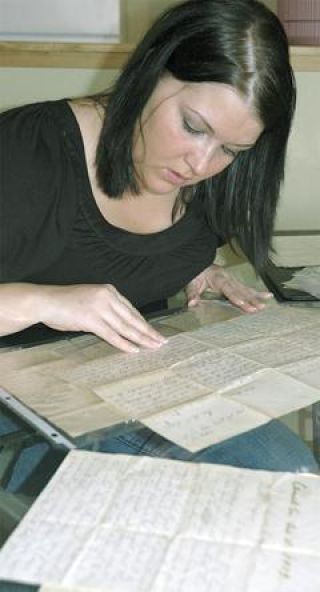A heartfelt, hand-written letter can connect families and friends, bringing news of home that spans the miles.
Or, when taken in a historical context, personal notes can even transcend generations, connecting people to family members who passed long ago.
Enumclaw’s Channa Carsey found herself in a caretaker’s role, hanging on to a package of eight letters penned more than 100 years ago. While she was the legal owner of the family notes, Carsey knew the letters weren’t hers to keep. Her quest to get them in the proper hands is a story that crosses three generations and an equal number of time zones.
Carsey’s tale began more than two years ago when she - playing the role of the dutiful daughter - accompanied her mother to a Plateau yard sale. The ironic thing is that Carsey, 27, is no fan of such outings.
“I think it’s awful to sell other people’s stuff,” she said.
But she tagged along, digging through miscellaneous items while her mother shopped. What eventually caught her eye was a bundle of letters exchanged more than 140 years ago between sisters who originally hailed from the tiny town of Camak, Ga. Drawn to the personal notes crafted in cursive, she paid handsomely for the letters, $480, and took them home.
The notes were safely tucked away for a time while a busy Carsey - she’s a single mother of three who attends nursing school - mulled her options. Eventually she began hunting for relatives of Sallie Holliman and her sister Anna. It was Sallie, who remained in Camak, who had written to her sister, who moved about; the letters were dated between 1879 and 1889.
She initially ran into a series of dead-ends, even after going so far as making random phone calls to Georgia to anyone with a Holliman surname.
But her luck changed when the Augusta Chronicle got wind of the story. Rob Pavey was assigned the story, interviewed Carsey by phone, and crafted an account of her desire to unite the lost letters with a family member. The story was a hit in the Southern town known best for hosting the Master’s golf tournament each year. Reader comments flooded in, near unanimous in their praise for such a feel-good story.
The story trickled in to Miss Jane’s Diner in small Warrenton, Ga., not far from either Augusta or Camak. “Everybody in town was in here talking about that story,” said owner Kathryn Wood, quoted in one of Pavey’s follow-up articles. More important was the fact that Wood recognized one of her regular customers, George Holliman, as just the person Carsey was hunting for.
Holliman, 83,is the grandson of Sallie Holliman, author of the letters. The World War II veteran is well known in Warrenton, having served as superintendent of the local school system from 1959 to 1981.
The goal of getting the missing letters back on Georgia soil struck a nerve with many, including James Newsome of Warrenton, who rallied a fundraising effort to help offset the costs of Carsey’s planned trip south. Donations were funneled through the Warren County Chamber of Commerce and the local post of the American Legion.
Eventually, cash and plans came together and Carsey departed SeaTac International Airport July 31. A day later, she was sitting in Miss Jane’s Diner, playing a starring role in a surprise luncheon that brought her face-to-face with George Holliman. After taking possession of the long-lost letters, Holliman said he would donate them to the Warren County Library for all to see.
“It was nice to be able to meet him finally,” Carsey said, noting that she had previously spoken to Holliman on the telephone.
Now that she has handed off the letters, Carsey can begin putting the story to rest.
“I’m just happy that they’re home,” she said. “They really didn’t belong to me.”
The Reconstruction-era letters tell the story of daily life in a rural area. Yellowed with age, but neatly creased and still very legible, they tell of happy occasions like family gatherings, babies being born and folks getting married. But they also clearly paint a picture of tough times on the farm.
A Sallie Holliman letter dated Dec. 9, 1884, for example, chronicled the devastating effects of a whooping cough outbreak: “Charlie Lowe’s mother is dead and Sam Swint, too. Lib Kelley’s baby and Marie Williford’s baby. There is more babys buried out here than I can write - for I haven’t the paper. Lizzie Dixon’s was buried at 4 o’clock.”
The following June, she wrote: “They have had many deaths up here. Uncle Adams Jones, old Mrs. Lane Todd and Mrs Minerva Beall. Hannalain — John’s wife, is dead, left 7 children & little baby 1 day old. Mandy Ladrimus left 6 children, a baby a week’s old. Henry Bale’s baby is dead and Bill Johnson lost 2. Miss Liza Greene’s sister Nancy Grizzle is dead — left 8 children.”
But not all was darkness and gloom.
In January 1887, Holliman wrote: “We have had a good many marriages this winter. Susie and Neal, John Swint and Beulah Shellon. Henry Shelton & Mattie Woodward. Lawrence Realey & Ellen Shelton. Emma Hawkens & Charlie Walden.
In the same letter Holliman told of Sunday School gifts being handed out: “Clyde got a silk handkerchief. Bob got a wooden doll that would dance. Henry got five ground peas and 1 ear of corn & bottle of cologne. Ben Parham got a pone of cracklin bread and Old Man Freeman Johnson got a doll. Johnnie got a nursing bottle full of milk and a jelly lime. Some got mad, most was well pleased.”


